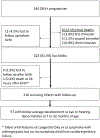Delayed childhood neurodevelopment and neurosensory alterations in the second year of life in a prospective cohort of ZIKV-exposed children
- PMID: 31285631
- PMCID: PMC6689256
- DOI: 10.1038/s41591-019-0496-1
Delayed childhood neurodevelopment and neurosensory alterations in the second year of life in a prospective cohort of ZIKV-exposed children
Abstract
We report neurodevelopmental outcomes in 216 infants followed since the time of PCR-confirmed maternal Zika virus (ZIKV) infection in pregnancy during the Rio de Janeiro epidemic of 2015-2016 (refs. 1,2). Neurodevelopment was assessed by Bayley Scales of Infant and Toddler Development, third edition (Bayley-III; cognitive, language and motor domains) in 146 children and through neurodevelopment questionnaires/neurological examinations in 70 remaining children. Complete eye exams (n = 137) and hearing assessments (n = 114) were also performed. Below-average neurodevelopment and/or abnormal eye or hearing assessments were noted in 31.5% of children between 7 and 32 months of age. Among children assessed by Bayley-III, 12% scored below -2 s.d. (score <70; a score of 100 ± 2 s.d. is the range) in at least one domain; and 28% scored between -1 and -2 s.d. in any domain (scores <85-70). Language function was most affected, with 35% of 146 children below average. Improved neurodevelopmental outcomes were noted in female children, term babies, children with normal eye exams and maternal infection later in pregnancy (P = 0.01). We noted resolution of microcephaly with normal neurodevelopment in two of eight children, development of secondary microcephaly in two other children and autism spectrum disorder in three previously healthy children in the second year of life.
Figures



Comment in
-
Reply to 'A critical analysis of neurodevelopmental and neurosensory outcomes after 2 years for children with in utero Zika virus exposure'.Nat Med. 2019 Nov;25(11):1642-1643. doi: 10.1038/s41591-019-0631-z. Nat Med. 2019. PMID: 31649351 Free PMC article. No abstract available.
-
A critical analysis of the neurodevelopmental and neurosensory outcomes after 2 years for children with in utero Zika virus exposure.Nat Med. 2019 Nov;25(11):1641-1642. doi: 10.1038/s41591-019-0630-0. Nat Med. 2019. PMID: 31649352 No abstract available.
References
-
- Kapogiannis BG, Chakhtoura N, Hazra R & Spong CY Bridging Knowledge Gaps to Understand How Zika Virus Exposure and Infection Affect Child Development. JAMA Pediatr. 171, 478 (2017). - PubMed
References (Methods only)
-
- von der Hagen M et al. Diagnostic approach to microcephaly in childhood: a two-center study and review of the literature. Dev. Med. Child Neurol. 56, 732–741 (2014). - PubMed
-
- Bayley N Bayley Scales of Infant and Toddler Development: Administration Manual. (2006).
-
- Madaschi V, Mecca TP, Macedo EC & Paula CS Bayley-III Scales of Infant and Toddler Development: Transcultural Adaptation and Psychometric Properties. Paidéia (Ribeirão Preto) 26, 189–197 (2016).
-
- Souza CT et al. Assessment of global motor performance and gross and fine motor skills of infants attending day care centers. Rev. Bras. Fisioter 14, 309–315 (2010). - PubMed

